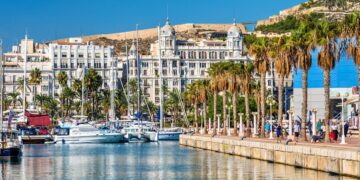The day I arrived on the Caribbean island of Trinidad I, along with seemingly all the islanders, went to a cricket match at Queens Park Oval in the capital, Port of Spain. Trinidad’s Knight Riders were playing Guyuna’s Amazon Warriors.
Trinidad’s Knight Riders vs Guyuna’s Amazon Warriers cricket match at the Oval
This was my debut cricket match and any preconceptions of anything genteel were quickly bowled out. The party atmosphere was pumped with Soca music, acrobats, and dancers, and at every 6 or wicket, the crowd erupted into dancing, twerking with abandon.
Meanwhile, Independence Day bunting was everywhere. A former Spanish colony by virtue of Christopher Columbus then ceded to the Brits in 1797 the nation finally achieved independence in 1962 and celebrated with gusto every September.
There was merriment in the air and I was told by a local with a charming lilt “People here are forthright and say what they mean – this is not a PC country and no one takes offense – we laugh instead”.
There is an ingrained sense of humour in this multicultural society, a mash-up of African, Indian, Middle Eastern, Chinese, and European heritage. It’s all upbeat just like their Soca music – think calypso but with more soul sprinkled with a blend of African and East Indian rhythms with a bit of Reggae and Latin.
And the charming Steel Pan orchestral music. The most famous orchestra is the 80-strong Shell Invaders who were founded almost 100 years ago. Get there in February and you will hear them playing at Trinidad’s annual carnival.
Trinidad is its own island, and yet one nation with Tobago around 30km away. Many pass over Trinidad in search of the paradise sand and sea of Tobago. Trinidad is mountainous and lush and has plenty to offer explorers who are happy to “lime,” – hang out – and/or explore its valleys.
A whizz around the capital, Port of Spain, Trinidad
Gingerbread houses
San Juan, Trinidad Photo by Kenrick Baksh on Unsplash
Port of Spain, is clad in low-rise pastel-coloured buildings especially around San Juan, with some high rises along the coast. The most stylish area is at Queen’s Park West where cutesy early 20th-century gingerbread houses have been renovated.
There are plenty of them but the must-sees are the Magnificent Seven around the Savannah at Queen’s Park. Opposite is the sprawling Queens Park Savannah public park, once part of a sugar plantation and now the site of the annual carnival, and nearby is the Anglican, Gothic-designed Holy Trinity Cathedral and the Emperor Zoo and Royal Botanical Gardens.
Central Market
For a glimpse into local life, I visited Central Market on Beetham Highway. Fruit and veg, peppers, all manner of food as well as a fish section are available. Vibrant, colourful, and lively with local treats and Indian sweets from producers and farmers from all over Trinidad.
House of Angostura

The company set up its distillery in Port of Spain in the mid-19th Century and to this day its recipe for the Angostura bitters remains cloaked in secrecy. The company is also the biggest rum producer. Still, a tour of the distillery and its museum is an interesting way to spend an afternoon. Oh and check out their quirky butterfly collection and art collection.
From Maraval to La Vigie Paramin Lookout


I have a deep appreciation for breathtaking vistas, and Trinidad boasts an abundance of them. Among the most renowned is La Vigie in Paramin. We embarked on a winding ascent of 940 meters (3084 feet) from Maraval, a suburb of Port of Spain, to reach the picturesque village of Paramin. Nestled on one of the highest points in the western region of the Northern Range mountains, the journey took us through a valley adorned with palm trees, across the North Coast Road, and up some of the steepest slopes. It was a challenging drive, even in a rugged Jeep, but the scenic beauty along the way was truly spectacular. Additionally, there were delightful surprises to be found during our journey, as we passed by sprawling mountain villages and fertile lands where cottage industries have thrived.


We made a stop to gather some supplies at M&M Preservatives, a business operated by sisters Marlene Gonzales and Marcia Pierre. Their property is surrounded by avocado trees, sorrel plants, and pepper bushes. Here, they craft homemade delights such as pepper sauces, coconut fudge, kurma, toolum, sorrel juice, and even homemade ice cream.
Continuing our journey, we passed by the Church of Guadalupe, a Roman Catholic Church constructed using stones dynamited from the land. As we navigated a bend in the road, we encountered a prominent photograph of Francis Felix, renowned as the oldest resident of Trinidad & Tobago. He passed away in 2017 at the remarkable age of 111, and this site serves as a memorial in his honor.
Experience the Caroni Swamp with Nanan’s flat-bottom boat excursion.
In 1962, when Trinidad and Tobago gained its independence, the Scarlet Ibis was chosen as the National Bird of Trinidad. The prime location to witness these striking red birds, along with approximately 180 other bird species, including the elegant pink flamingo, is the Caroni Swamp. Within this expansive 40-square-mile area of mangroves and swamp, you can also find 40 species of fish, various types of snakes, crabs, and crab-eating raccoons.
Nanan’s Caroni Bird Sanctuary Tours, a family-run business with nearly a century of experience, provides a well-crafted adventure aboard a flat-bottomed boat. Their expert guides will point out sleeping snakes and other fascinating wildlife along the way.
As you glide through the mangroves, a delightful dinner is served, culminating in your arrival at the island where the region’s birds congregate.
The Beaches
You can easily access two beautiful beaches from the capital by taking the route through Santa Cruz or San Juan to the North Coast Road. I enjoyed a relaxing swim in the warm waters of the peaceful Las Cuevas Bay, which proudly boasts a Blue Flag designation.
During my descent to the beach, I purchased a coconut from a local vendor who had a lit joint in his mouth. Sipping on the refreshing coconut water, I gazed out at the Caribbean Sea, entranced by the rhythmic ebb and flow of the waves caressing the soft sands.
When hunger struck, we made our way to the bustling Maracas Beach nearby. At Richard’s rustic wooden shack restaurant, we savored the offerings from the Bake and Shark menu. This cuisine is a quintessential Trinidadian fast food, often described as a classic street food, where delectable dishes are served on fried flatbread.
The place was quite popular, and our tour host, Tano Harewood, the owner of Island Tours, skillfully navigated the lengthy lines to collect our orders. I opted for a Trini Aloo Pie, a pastry filled with seasoned mashed potatoes and then deep-fried. Others in our group selected options like shrimp or shark.
Embark on a cruise to explore the Gasparee Caves and the surrounding islands.
A brief 10-minute boat voyage departing from Chaguaramas, situated to the west of Port of Spain, transports you to the charming Gaspar Grande island. Following a 30-minute hike, you’ll arrive at the splendidly illuminated limestone caverns of Gasparee Caves, which are certainly worth exploring to admire the stalagmites and stalactites, as well as the enchanting play of sunlight on the saltwater pool at the base known as the Blue Grotto. The atmosphere within is truly captivating, and according to our knowledgeable tour guide, Leann Kirton, this location has also served as a venue for weddings.
The ideal approach is to embark on a guided tour that includes an expert guide to showcase the breathtaking wildlife and plant life, followed by a scenic boat excursion around the islands. Our adventure took place aboard the “Life is Good” speedboat, which navigated one of the sea channels within Boca del Dragon. From this vantage point, we enjoyed views of Venezuela. Along the way, we made stops at Scotland Bay and Sandy Bay, where we were fortunate enough to witness turtles emerging from the water and spot an anhinga bird perched on the rocks. Afterward, back on the boat, we were treated to a delicious lunch and refreshing rum cocktails, and we had the opportunity to take a dip in the inviting waters of the Caribbean Sea.
Image:Getty Images

























































Wow, the Caroni Swamp boat excursion sounds like a crocodiles paradise! Cant wait to visit!
Who needs a travel guide when you can just follow the sound of steelpan music? #IslandVibes
I never knew Trinidad had such stunning beaches! Definitely adding it to my bucket list.
I heard Trinidad has the best beaches! But what about the crime rate?
Trinidad does offer stunning beaches, no doubt. As for the crime rate, its always essential to exercise caution and do your research beforehand. Its wise to stay informed and take necessary precautions while enjoying the beauty this place has to offer.
Who needs beaches when youve got the Caroni Swamp? Embrace the unusual and explore natures wonders!
I heard Trinidad has beaches, but are they better than Tobagos?
I dont get the hype. The beaches in Trinidad are overrated. Give me Tobago any day!
I couldnt disagree more! Trinidads beaches are simply breathtaking, with their crystal-clear waters and pristine sands. Tobago may have its charm, but the allure of Trinidads beaches is undeniable. Its all a matter of personal preference, I suppose.